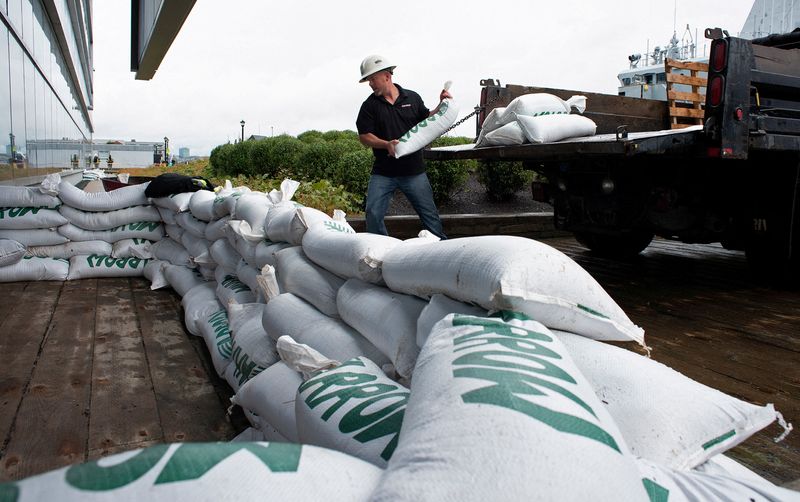Canada braces for possibly historic storm in Hurricane Fiona
2022.09.24 02:28
[ad_1]

© Reuters. FILE PHOTO: Francis Bruhm, Project Manager for general contractor G&R Kelly, places sandbags around the doors of the Nova Scotia Power building before the arrival of Hurricane Fiona in Halifax, Nova Scotia, Canada September 23, 2022. REUTERS/Ingrid Bulme
By Eric Martyn and Ismail Shakil
HALIFAX, Nova Scotia (Reuters) – Eastern Canada on Saturday braced for what could become one of the most severe storms in the country’s history as Hurricane Fiona barreled toward Nova Scotia nearly a week after devastating parts of the Caribbean.
Experts predicted high winds, storm surges and heavy rainfall from Fiona, which was expected to weaken from its Friday night status as a Category 3 hurricane but remain a hurricane-force cyclone as it moves across Atlantic Canada.
Prime Minister Justin Trudeau delayed Saturday’s departure for Japan, where he was to attend the funeral of slain former Prime Minister Shinzo Abe, to receive briefings and support the government’s emergency response, Press Secretary Cecely Roy said on Twitter (NYSE:).
Maximum sustained winds reached 105 mph (165 kph) on Friday night, with a hurricane warning in effect for much of central Nova Scotia and Prince Edward Island, home to more than 150,000 people, and parts of Newfoundland, the U.S. National Hurricane Center said.
It was due to make landfall in eastern Nova Scotia Saturday morning, but rain and wind had already started Friday night.
“The center of it is one thing, but the weather that’s associated with it in terms of the rain and where all the strong winds are, it’s going to be over a much larger area,” Canadian Hurricane Centre meteorologist Ian Hubbard said.
“Many, many places away from the center of the storm are still going to be seriously impacted from this,” Hubbard told Reuters.
There will be rough and pounding surf, with waves as high as 10 meters (33 feet) expected to hit the eastern shore of Nova Scotia Friday night.
Canadian authorities sent emergency alerts in Nova Scotia and Prince Edward Island, warning of severe flooding along shorelines and extremely dangerous waves. People in coastal areas were advised to evacuate.
“We’ve had a few before, but they say this is going to be the biggest of them all,” said Chris MacPhee, 53, of Sydney, Nova Scotia, who stocked up on groceries, batteries and candles. He said he was feeling “a little nervous, I guess.”
The storm could prove more ferocious than the benchmarks of Hurricane Juan in 2003 and Hurricane Dorian in 2019, Canadian Hurricane Centre meteorologist Bob Robichaud told a briefing.
The country’s two largest carriers, Air Canada and WestJet Airlines, suspended regional service starting Friday evening.
Fiona had already battered Caribbean islands earlier in the week, killing at least eight and knocking out power for virtually all of Puerto Rico’s 3.3 million people during a sweltering heat wave. Nearly a million customers remained without power five days later.
Trailing Fiona in the Caribbean is Tropical storm Ian, which is expected to become a hurricane on Sunday night. The NHC said that a hurricane watch is in effect for Cayman Islands.
The storms’s projected path takes it just south of Jamaica, over western Cuba and into Florida early next week, the hurricane centre said.
Florida Governor Ron DeSantis declared a state of emergency on Friday, freeing up funding and emergency services in advance of the storm.
(Reporting Eric Martyn in Halifax and Ismail Shakil in Ottawa; Additional reporting by Ivelisse Rivera in San Juan, Puerto Rico and Juby Babu in Bengaluru; Writing by Daniel Trotta; editing by Diane Craft and Gerry Doyle)
[ad_2]
Source link








